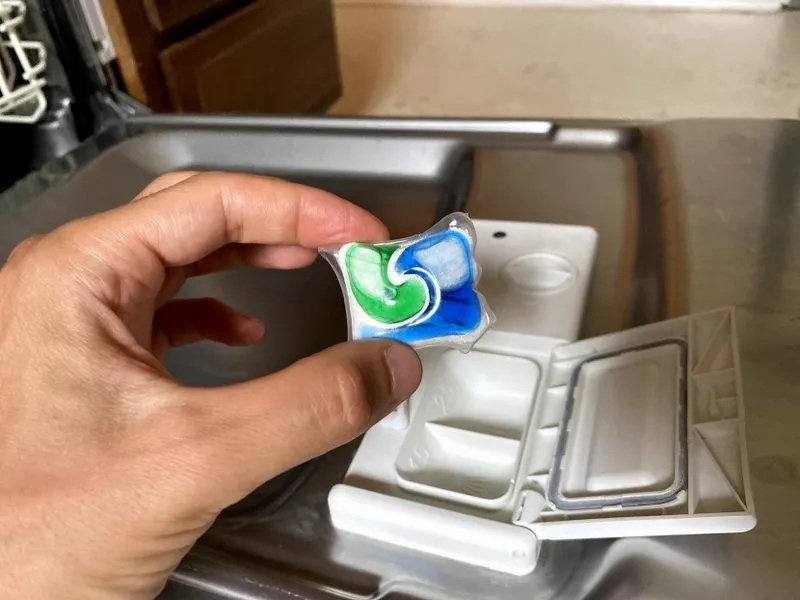Dongguan UFine Daily Chemical Co.,Ltd.
- All
- Product Name
- Product Keyword
- Product Model
- Product Summary
- Product Description
- Multi Field Search
Views: 222 Author: Tomorrow Publish Time: 11-18-2025 Origin: Site











Content Menu
● Understanding the Design of Jetted Bathtubs
● What Are Dishwasher Pods Made Of?
● Can You Use a Dishwasher Pod in a Jetted Bathtub?
● Step-by-Step: How to Clean a Jetted Tub Using a Dishwasher Pod (Occasionally)
>> 1. Fill the Tub with Warm Water
>> 2. Add a Single Dishwasher Pod
● Safer Alternatives for Cleaning Jetted Bathtubs
>> Commercial Jet System Cleaners
>> Regular Maintenance Vinegar Rinse
● How Often Should You Clean a Jetted Tub?
● Why Chemical Balance Matters
● The Science of Jet System Buildup
● Troubleshooting Common Jet Cleaning Problems
● Eco-Friendly Cleaning Practices
● Comparison: Dishwasher Pods vs. Jetted-Tub Cleaners
● FAQ
>> 1. Can dishwasher pods damage a jetted bathtub?
>> 2. How often should jetted tubs be cleaned?
>> 3. What is the safest cleaning mixture?
>> 4. Can regular dish soap be used instead?
>> 5. How can you prevent jet buildup?
Maintaining a clean and sanitary jetted bathtub can be challenging. The inner pipes and jets collect oils, soap, and residues that create unpleasant smells and reduce performance over time. Many homeowners look for convenient shortcuts to clean their tubs, and some wonder: can a simple dishwasher pod do the job?
At first glance, this idea sounds practical. Dishwasher pods are powerful cleaning agents that dissolve grease, eliminate residue, and fight bacteria. However, not all cleaning products designed for kitchen use are safe for bathroom fixtures—especially those with mechanical water systems.
This article explores how jetted bathtubs work, what dishwasher pods contain, whether they can be safely used in these systems, and what alternatives work best for long-term maintenance.

Jetted bathtubs, sometimes called whirlpool tubs or spa baths, feature built-in jets that push a mix of water and air through small openings in the sides of the tub. The jets are connected to a network of pipes and a motorized pump that circulates water under pressure.
While this creates a relaxing massage effect, it also traps contaminants inside the plumbing. Each use introduces body oils, dead skin cells, soaps, and lotions into the system. Over time, these materials form sticky films and bacterial biofilms within the jet lines.
Because the system is enclosed, simple surface cleaning is not enough. Regular internal cleaning is essential to preserve hygiene and avoid foul odors. However, using the wrong cleaning agents may cause more harm than good by corroding parts or leaving irritant residues.
Dishwasher pods are engineered to clean kitchenware efficiently in high-temperature water under mechanical agitation. Their compact capsules usually contain three key cleaning compounds:
1. Enzymes: These break down food residues, starches, and proteins.
2. Surfactants: They dissolve oils and reduce surface tension, allowing water to rinse grime away easily.
3. Builders and Bleaching Agents: These remove stains, neutralize acids, and prevent limescale.
Additionally, dishwasher pods may include rinse aids, fragrance agents, and non-foaming detergents to optimize cleaning in closed dishwasher systems. While these compounds are safe for hard materials like steel, glass, and ceramic, their interaction with acrylic and rubber components in bathtubs is quite different.
Some cleaning experts and do-it-yourself enthusiasts claim that a single dishwasher pod can be used to deep-clean a jetted tub effectively. The pod, when dissolved in warm water and circulated through the system, can loosen grime and detergent buildup.
However, this technique comes with several warnings:
- Excessive Foaming: Although dishwasher pods are typically low-sudsing, when used in open water and jets, they can produce foam that exceeds the tub's edge, creating slippery messes.
- Chemical Sensitivity: Jet systems are sensitive to harsh chemicals that can degrade rubber seals, corrode metal parts, or damage acrylic coatings.
- Residue Hazard: Dishwasher detergents are not meant to contact skin directly. Residual traces left in the jets may cause irritation or allergic reactions.
- Motor Stress: Some components in jetted tub motors and plumbing are not designed to handle thick detergent solutions.
Using a pod once for a deep clean may not cause immediate damage, but frequent use can shorten the life of seals, jets, and interior finishes.
If you still choose to use a dishwasher pod as a one-time cleaning method, follow these steps carefully to minimize risk.
Fill the tub to at least two inches above the jets. The warm temperature helps dissolve grease and allows the detergent to circulate effectively.
Drop only one pod into the water. Avoid using more, as extra detergent will lead to uncontrollable foaming.
Run the jets for about 15 minutes. This allows the pod to circulate and clean internal pipes and surfaces.
Once the cleaning cycle is done, drain the dirty water completely. Refill the tub with clean warm water and run the jets again for 10 minutes to flush away remaining detergent.
Wipe the tub dry with a microfiber cloth. Check for leftover residue, and ensure no foam remains in the piping system.
This method works in emergencies or for periodic deep-cleaning if used sparingly. However, safer long-term alternatives are recommended for regular maintenance.
Using natural or specialized cleaners reduces chemical risks while effectively maintaining hygiene.
A classic cleaning duo, vinegar dissolves calcium deposits and neutralizes bacteria, while baking soda provides mild abrasion to remove residues. Combine two cups of white vinegar with half a cup of baking soda, then fill the tub with warm water above the jets. Run the jets for 15 minutes, drain, refill with clean water, and rinse again.
Hydrogen peroxide is a gentle bleaching and disinfecting agent. Mixed with warm water, it helps eliminate mold and odor-causing microbes without harming finishes.
Specialized cleaners are formulated to dissolve biofilm and residue safely inside jetted systems. They contain mild surfactants and corrosion inhibitors tailored for acrylic tubs and internal plumbing.
For those who use their jetted tubs frequently, running a mixture of one part vinegar and two parts water through the system every two weeks can prevent buildup entirely.

1. Avoid oily bath additives: Lotions, essential oils, and bubble baths accelerate residue buildup.
2. Rinse the tub after every use: A quick rinse prevents soap scum accumulation.
3. Deep clean monthly: Run cleaning cycles regularly to keep jets clear.
4. Wipe surfaces dry: Prevent moisture and mold from forming around jets and edges.
5. Inspect regularly: Listen for weaker jet pressure or unusual noises, which can signal blockage or buildup.
Following these steps ensures your tub remains safe, clean, and mechanically sound for years.
Usage frequency determines cleaning needs. For occasional users, cleaning every one to two months is adequate. For those who enjoy their jetted tub weekly or daily, cleaning once every two weeks is best.
Environmental factors such as hard water can also influence cleaning frequency. Hard water leaves mineral deposits inside the jets, reducing water pressure and efficiency. In such cases, more regular vinegar rinses can help prevent scaling and equipment wear.
The main reason to be cautious about using dishwasher pods or detergents is the difference in chemical balance. Dishwasher solutions have an alkaline pH level, designed to break down tough food residues. Bathtubs, however, are made of acrylic or composite materials that respond poorly to prolonged exposure to high-alkaline substances.
The buildup from these cleaners can etch or dull the tub's surface, leading to permanent cloudiness. Additionally, rubber gaskets and nozzle rings may shrink, harden, or crack over time, reducing the system's watertight seal.
Therefore, understanding pH compatibility ensures your cleaning regimen preserves beauty and performance.
Biofilm forms when organic matter—skin oils, soap scum, and bacteria—accumulates inside damp, enclosed pipes. Once a thin layer of this matrix develops, it becomes resistant to simple rinsing.
Running warm water through the jets provides a perfect environment for microbial growth. Over time, these microscopic films generate foul odors and discoloration.
This is why regular jet-cleaning solutions rely on mild oxidizing and surfactant-based formulas that dissolve organic film safely. Heavy detergents like those in dishwasher pods react similarly but are not fine-tuned for bathtub plumbing tolerance, creating cleaning efficiency at the expense of long-term durability.
Even with regular upkeep, certain issues may arise.
- Persistent odor: Run an extra cleaning cycle with vinegar and hot water. Add hydrogen peroxide if the smell persists.
- Foam overflow: When excessive foam occurs during cleaning, immediately turn off the jets and drain the tub. Refill with clean warm water and run an additional rinse cycle.
- Weak jet flow: Check for partial clogs near the intake cover or within the jet. Use a toothbrush or non-abrasive cleaning brush to clear visible debris.
- Spitting jets or bubbles: Air trapped in the piping after cleaning can cause irregular flow. Bleed the air by running the system for several minutes.
Learning how your specific tub model reacts to different cleaning methods helps maintain ideal performance without expensive repairs.
Sustainable cleaning not only protects your tub but also benefits the environment. Consider these green habits:
1. Use biodegradable cleaning products with plant-based surfactants.
2. Avoid chlorine or ammonia-based cleaners.
3. Use reusable microfiber cloths instead of disposable wipes.
4. Drain cleaning water responsibly to avoid sending harsh chemicals into the environment.
Opting for natural products ensures both safety and ecological harmony.
| Feature | Dishwasher Pod | Jetted-Tub Cleaner |
|---|---|---|
| Designed for | Dishwashers | Whirlpool and jetted tubs |
| Suds level | Moderate | Low or none |
| Chemical intensity | High | Gentle, balanced |
| Risk to tub materials | Medium to high | Low |
| Residue safety on skin | Unsafe | Safe |
| Recommended use frequency | Rarely/Ocassional | Monthly or regular |
This comparison highlights why specialized cleaners are consistently better choices for maintaining system health and user comfort.
Dishwasher pods can clean a jetted bathtub in certain situations, but they are not ideal long-term solutions. Their powerful detergents may effectively remove grime but also risk damaging sensitive components over time. The best approach involves using vinegar, baking soda, hydrogen peroxide, or commercial products designed specifically for whirlpool systems.
With consistent maintenance and the right cleaning schedule, you can ensure your jetted bathtub remains a luxurious and hygienic retreat for years. Always choose gentle, pH-balanced methods to preserve your investment and avoid costly repairs.

Yes. Prolonged or frequent use may degrade rubber seals, acrylic coatings, and internal metal components due to chemical strength.
Once every two to four weeks depending on usage. Frequent users should clean more regularly to prevent buildup.
A combination of white vinegar and baking soda or a dedicated jetted-tub cleaner ensures safety and effective cleaning without harmful effects.
No. Dish soap generates excessive foam that can overflow and leave residue in pipes, making rinsing difficult and time-consuming.
Rinse the tub after every use, avoid adding oils or bubble bath products frequently, and perform monthly cleaning cycles with mild solutions.